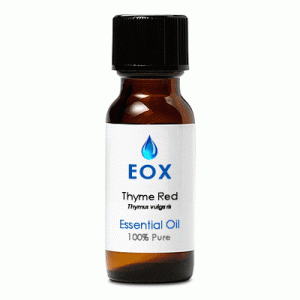|
Characteristics:
A red, brown, or orange liquid with a warm, spicy-herbaceous, powerfully penetrating odor.
Principal Constituents:
These are naturally occuring in the essential oil.
- thymol
- carvacrol
- cymene
- terpinene
- camphene
- borneol
- linalol
General Actions:




 Open Symbols Key
Open Symbols Key
Anthelmintic, anti-oxidant, antiputrescent, antirheumatic, antiseptic
(intestinal, pulmonary, genito-urinary), antispasmodic, antitussive, antitoxic, aperitif, astringent,
aphrodisiac, balsamic, carminative, cicatrizant, diuretic, emmenagogue, nervine, revulsive,
rubefacient, parasiticide, stimulant (immune system, circulation), sudorific, tonic, vermifuge.
Safety:

Contra-indicated in cases of high blood pressure. Red thyme oil, serpolet
(from wild thyme), 'thymol' and 'carvacrol' type oils all contain quite large amounts of toxic phenols;
this considered, however, 'thymol' is widely used in surgical dressings, disinfectants, etc.
Primary Therapy Agent:
Catarrh, laryngitis, hoarseness, sore throat, throat infections, colds/flu.
Secondary Therapy Agent:
Acne, boils, abscesses, blisters, bruises, cuts/sores, dermatitis, eczema, greasy
or oily skin/scalp, insect bites, lice, mouth and gum infections, scabies, aches and pains, arthritis,
cellulitis, gout, muscular cramp, muscle stiffness, poor circulation, low blood pressure, rheumatism,
sprains, strains, asthma, bronchitis, indigestion, flatulence, cystitis, fever, headache, insomnia,
nervous exhaustion, fatigue, nervous tension, stress-related conditions.
Important Note:
The information on Florapathics.com is
only provided for educational purposes, and further research should be done
on each essential oil to be assured of its proper usage for each individual.
Aromatherapy is not meant to be a replacement for care under a qualified
health professional, but should be considered a complimentary modality.
|











